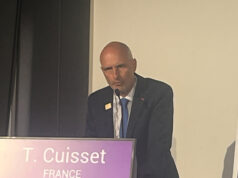
Registry data for younger patients—under 75 years—undergoing transcatheter aortic valve implantation (TAVI) is associated with similar in-hospital outcomes to propensity-matched patients undergoing surgical aortic valve replacement. However while TAVI patients were less likely to have postoperative delirium, they did more frequently need a new pacemaker.
Study investigators Holger Eggebrecht (Cardioangiologisches Centrum Bethaniem and AGAPLESION Bethanien Hospital, Frankfurt, Germany) and others write in EuroIntervention that data indicate that TAVI is “at least” non-inferior to surgery for intermediate-risk patients. However, they observed that most studies have focused on older patients, commenting: “Even in the randomised all-comer (low-risk) NOTION (Nordic aortic valve intervention) trial, the mean age was still 79.1 years”. They add that despite the lack of evidence for TAVI in younger patients, “recent registry data have indicated that there is a trend for an increasing number of lower risk and younger patients with symptomatic aortic stenosis to be subjected to TAVI over surgical aortic valve replacement”.
Therefore, in the present study, Eggebrecht et al reviewed data from the Germany Quality Assurance Registry on Aortic Valve Replacement to evaluate the outcomes of younger patients (<75 years) undergoing TAVI (via the transfemoral approach) compared with those undergoing surgery.
Of 6,972 patients aged under 75 in the registry, the majority (82.4%) underwent surgery. While TAVI patients tended to be older and have more comorbidities than did surgical patients, just over half (55.5%) were considered to be low risk for surgery and 28.1% were at intermediate risk—only 16.4% were at high risk.
In a propensity-matched analysis, the mean age of patients was 71.7 years in the surgery group and 71.5 years in the TAVI group (694 patients in each group). The authors report: “The vast majority of patients were at low risk, with a logistic EuroSCORE I <10% in 95.5% of surgical aortic valve replacement patients and 86.3% of TAVI patients. Only 0.4% and 1.9% were at high surgical risk, respectively.”
The rates of in-hospital mortality, stroke/transient ischaemic attack, and myocardial infarction were similar between groups. Surgical patients had a three-fold higher rate of postoperative delirium and had a greater need for dialysis than had TAVI patients. However, TAVI patients had more than four-fold increase in the need for a new pacemaker. According to Eggebrecht et al, the rate of new pacemaker after TAVI “remains a concern” and they note that this is particularly the case for younger patients with longer life expectancy “and thus higher chances of experiencing technical complications of the pacemaker device or its electrodes or developing long-term consequences of right ventricular pacing”.
Additionally, in-hospital stay was shorter with TAVI and more TAVI patients were discharged to home rather than to another hospital/rehabilitation unit. The authors observe: “This, together with less postoperative delirium and shorter hospital stays suggest that recovery after the less invasive TAVI procedure was less demanding.”
Concluding, they state: “Further randomised studies are needed in younger patients to confirm these favourable in-hospital results during long-term course.”
Eggebrecht told Cardiovascular News: “These results are very reassuring that TAVI will be the treatment of choice also for younger patients, once the issue of [TAVI] valve durability has been solved.”










